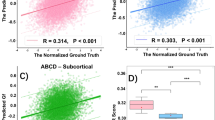Abstract
The brains of adolescents undergo profound cognitive development, especially the development of fluid intelligence (FI) that is the ability to reason and think logically (independent of acquired knowledge). Such development may be influenced by many factors, such as changes in the brain structure caused by neurodevelopment. Unfortunately, the association between brain structure and fluid intelligence is not well understood. Cross-sectional structural MRI data released by the Adolescent Brain Cognitive Development (ABCD) study pave a way to investigate adolescents’ brain structure via MRIs, but each 3D volume may contain irrelevant or even noisy information, thus degrading the learning performance of computer-aided analysis systems. To this end, we propose a discriminative-region-aware residual network (DRNet) to jointly predict FI scores and identify discriminative regions in brain MRIs. Specifically, we first develop a feature extraction module (containing several convolutional layers and ResNet blocks) to learn MRI features in a data-driven manner. Based on the learned feature maps, we then propose a discriminative region identification module to explicitly determine the weights of different regions in the brain, followed by a regression module to predict FI scores. Experimental results on 4, 154 subjects with T1-weighted MRIs from ABCD suggest that our method can not only predict fluid intelligence scores based on structural MRIs but also explicitly specify those discriminative regions in the brain.
Access this chapter
Tax calculation will be finalised at checkout
Purchases are for personal use only
Similar content being viewed by others
References
Carroll, J.B., et al.: Human Cognitive Abilities: A Survey of Factor-analytic Studies. Cambridge University Press, Cambridge (1993)
Jaeggi, S.M., Buschkuehl, M., Jonides, J., Perrig, W.J.: Improving fluid intelligence with training on working memory. Proc. Nat. Acad. Sci. U.S.A. 105(19), 6829–6833 (2008)
Casey, B., Giedd, J.N., Thomas, K.M.: Structural and functional brain development and its relation to cognitive development. Biol. Psychol. 54(1–3), 241–257 (2000)
Casey, B., Getz, S., Galvan, A.: The adolescent brain. Dev. Rev. 28(1), 62–77 (2008)
Baron, J., Chetelat, G., Desgranges, B., Perchey, G., Landeau, B., De La Sayette, V., Eustache, F.: In vivo mapping of gray matter loss with voxel-based morphometry in mild Alzheimer’s disease. NeuroImage 14(2), 298–309 (2001)
Lian, C., Liu, M., Zhang, J., Shen, D.: Hierarchical fully convolutional network for joint atrophy localization and Alzheimer’s disease diagnosis using structural MRI. IEEE Trans. Pattern Anal. Mach. Intell. (2018)
Giedd, J.N., et al.: Brain development during childhood and adolescence: a longitudinal MRI study. Nat. Neurosci. 2(10), 861 (1999)
Volkow, N.D., Koob, G.F., Croyle, R.T., Bianchi, D.W., Gordon, J.A., Koroshetz, W.J., Pérez-Stable, E.J., Riley, W.T., Bloch, M.H., Conway, K., et al.: The conception of the ABCD study: from substance use to a broad NIH collaboration. Dev. Cogn. Neurosci. 32, 4–7 (2018)
Zhang, J., Gao, Y., Gao, Y., Munsell, B.C., Shen, D.: Detecting anatomical landmarks for fast Alzheimer’s disease diagnosis. IEEE Trans. Med. Imaging 35(12), 2524–2533 (2016)
Li, G., Liu, M., Sun, Q., Shen, D., Wang, L.: Early diagnosis of autism disease by multi-channel CNNs. In: Shi, Y., Suk, H.-I., Liu, M. (eds.) MLMI 2018. LNCS, vol. 11046, pp. 303–309. Springer, Cham (2018). https://doi.org/10.1007/978-3-030-00919-9_35
Kingma, D.P., Ba, J.: Adam: a method for stochastic optimization. arXiv preprint arXiv:1412.6980 (2014)
Akshoomoff, N., et al.: NIH toolbox cognitive function battery (NIHTB-CFB): measuring executive function and attention. Monogr. Soc. Res. Child. Dev. 78, 119–132 (2013)
Liu, M., Zhang, J., Yap, P.T., Shen, D.: View-aligned hypergraph learning for Alzheimer’s disease diagnosis with incomplete multi-modality data. Med. Image Anal. 36, 123–134 (2017)
Krizhevsky, A., Sutskever, I., Hinton, G.E.: Imagenet classification with deep convolutional neural networks. In: NIPS, pp. 1097–1105 (2012)
Pan, Y., Liu, M., Lian, C., Xia, Y., Shen, D.: Disease-image specific generative adversarial network for brain disease diagnosis with incomplete multi-modal neuroimages. In: Shen, D., et al. (eds.) MICCAI 2019. LNCS, vol. 11766, pp. 137–145. Springer, Cham (2019)
Jung, R.E., Haier, R.J.: The parieto-frontal integration theory (P-FIT) of intelligence: converging neuroimaging evidence. Behav. Brain Sci. 30(2), 135–154 (2007)
Author information
Authors and Affiliations
Corresponding authors
Editor information
Editors and Affiliations
Rights and permissions
Copyright information
© 2019 Springer Nature Switzerland AG
About this paper
Cite this paper
Pan, Y., Liu, M., Wang, L., Xia, Y., Shen, D. (2019). Discriminative-Region-Aware Residual Network for Adolescent Brain Structure and Cognitive Development Analysis. In: Zhang, D., Zhou, L., Jie, B., Liu, M. (eds) Graph Learning in Medical Imaging. GLMI 2019. Lecture Notes in Computer Science(), vol 11849. Springer, Cham. https://doi.org/10.1007/978-3-030-35817-4_17
Download citation
DOI: https://doi.org/10.1007/978-3-030-35817-4_17
Published:
Publisher Name: Springer, Cham
Print ISBN: 978-3-030-35816-7
Online ISBN: 978-3-030-35817-4
eBook Packages: Computer ScienceComputer Science (R0)




